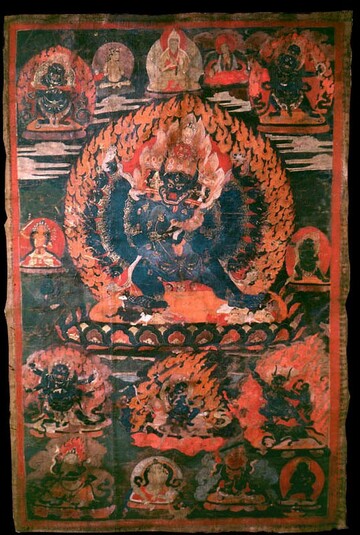
Item: Vajrabhairava (Buddhist Deity) - with consort
| Origin Location | Tibet |
|---|---|
| Date Range | 1700 - 1799 |
| Lineages | Gelug |
| Material | Ground Mineral Pigment on Cotton |
| Collection | Southern Alleghenies Museum of Art |
Classification: Deity
Appearance: Animal-Feature
Gender: Male
Vajrabhairava (Tibetan: dor je jig je. English: Vajra Terror) and the consort Vajra Vetali (Tib.: dor je ro lang ma): the wrathful tantric form of Manjushri. (See the Vajrabhairava Main Page, Outline Page and Forms of Manjushri: Context Page).
Blue-black in colour with 9 faces, 34 hands and 16 legs, the main face is that of a buffalo, with a red face above and the slightly angry yellow face of Manjushri placed on top between the two horns. With three faces to the right and three more to the left, each face has three large eyes, gaping mouths with frightful expressions. Dark yellow hair flows upward like flames. The first pair of hands hold a curved knife and skullcup and embrace the consort Vajra Vetali - dark blue, one face and two hands. Adorned with a variety of wrathful ornaments, standing with the right legs bent and the left straight. Both press upon various humans, animals, birds and gods, above an orange sun disc and multi-coloured lotus completely surrounded by the flames of pristine awareness.
At the top center is the Lord Tsongkapa performing the teaching gesture with the hands while holding the stems of two lotus blossoms supporting a sword and book. To the left is mahasiddha Virupa and to the right is the foremost teacher of the Sakya tradition Sachen Kunga Nyingpo. Again on the left is Mahakala Panjarnata and on the right Mahakala Chaturmukha - the wrathful form of Brahma Mahakala.
At the middle left is the bodhisattva Manjushri, orange in colour. At the right is the wrathful bodhisattva Vajrapani , blue in colour.
At the lower left is Mahakala Shadbhuja (Great Black One with Six Hands), Avalokiteshvara emanating as Mahakala, dark blue in colour, very wrathful and surrounded by flames. In the middle is Magzor Gyalmo, wrathful Sarasvati, with one face and two hands holding a stick and skullcup, riding a mule; surrounded by dark smoke. At the right is the special protector of the Vajra Bhairava Tantras, Yama Dharmaraja, dark blue, with the head of a buffalo, holding a bone stick and lasso. Embraced by the consort Chamundi, he rides on the back of a buffalo; surrounded by flame.
At the bottom left is the guardian of the northern direction, Vaishravana, yellow in colour with one face and two hands holding a victory banner and a mongoose; riding a snow lion. To the right is the god of wealth yellow Jambhala holding a bijapuraka fruit and a mongoose. To the right is the protector Begtse Chen, red in colour, wearing a silk pendent headdress and the garb of a Tibetan warrior. Held in the right hand is a sword and in the left a spear and heart; surrounded by flames. To the right is black Jambhala, naked, holding a skullcup and mongoose standing amidst a circle of orange flame.
As a tutelary deity Vajra Bhairava, also known as Yamantaka, belongs to the Yamari class of tantras and specifically arises from the Vajra Bhairava Root Tantra (Tibetan: jig je tsa gyu) and belongs to the method (father) classification of Anuttaryoga Tantra. The practice of Bhairava is common to the three Sarma Schools: Sakya, Kagyu and Gelugpa. There are numerous forms and styles of practice from the very complex mandalas with numerous deities to the very concise with a single Heruka form. The main lineages to enter Tibet were those of Jowo Atisha, Rwa Lotsawa, Mal Lotsawa and the like.
This form of Bhairava with the central faces placed 3 vertically and 3 faces at each side arranged horizontally is unique to the Gelugpa School and true to a visionary experience of Lord Tsongkapa the founder.
Lineage: Shri Vajrabhairava, Jnana Dakini, Mahasiddha Lalitavajra, Amoghavajra, Yeshe Jungne Bepa, Mahasiddha Padmavajra, Marmedze Srungwa, Rwa Lotsawa Dorje Drag, Rwa Chorab, Rwa Yeshe Sengge, Rwa Bum Seng, Rongpa Gwalo Namgyal Dorje, Rongpa Sherab Sengge, Lamdrepa Yeshe Palwa, Je Sonam Lhundrup, Choje Dondrup Rinchen, Je Tsongkapa Lozang Trakpa (1357-1419), etc.
Jeff Watt 10-98
Collection of Southern Alleghenies Museum of Art
Tradition: Gelug Deity Paintings
Buddhist Deity: Vajrabhairava Main Page
Collection of Southern Alleghenies: Deity
Buddhist Deity: Vajrabhairava & Gelug Protectors Composition
